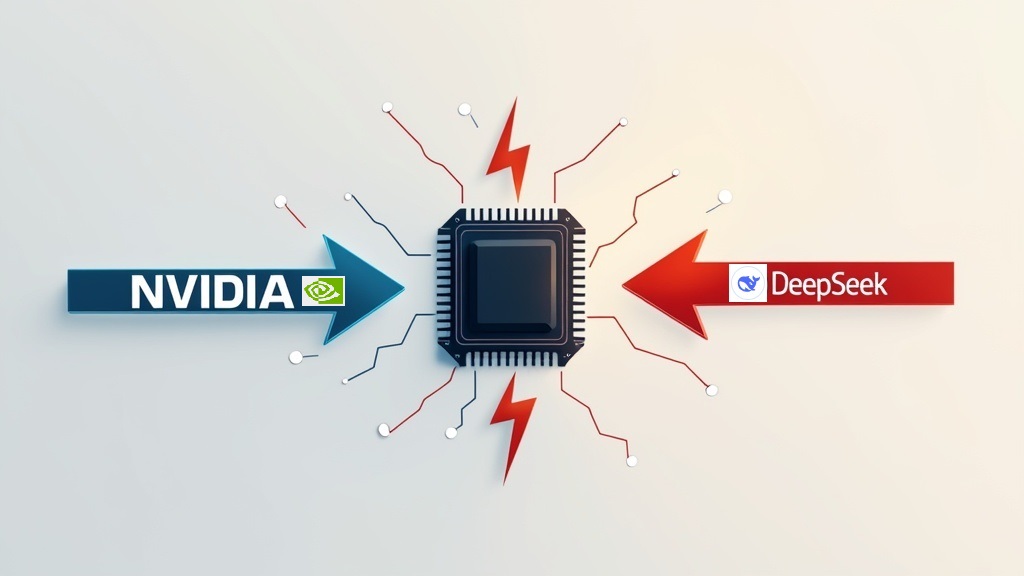AI’s Energy Revolution: How a Tech Breakthrough Sparked the Uranium Market Meltdown

Uranium stocks have taken a beating in recent weeks, with major players like Paladin Energy (ASX: PDN), Deep Yellow (ASX: DYL), Lotus Resources (ASX: LOT), and Bannerman Energy (ASX: BMN) seeing sharp declines of 10% to 20%. At first glance, this sell-off might seem like a ripple effect of the broader tech and AI market slump, but the real reason cuts much deeper—tied directly to the future of energy-hungry AI data centers and nuclear power. A Paradigm Shift: AI’s Energy Efficiency Undermines Nuclear’s Big Bet For months, uranium bulls had pointed to AI’s insatiable demand for power-hungry data centers as a key driver for the nuclear energy boom. The idea was simple: AI workloads require massive amounts of electricity, and nuclear power—a stable, carbon-free energy source—was expected to play a crucial role in meeting that demand. But that narrative changed overnight. A bombshell announcement from DeepSeek, a Chinese AI startup, revealed that it had developed a state-of-the-art AI model rivaling top competitors—but at a fraction of the energy cost. Unlike traditional AI models, which require hundreds of millions of dollars and enormous power consumption for training, DeepSeek’s approach slashed energy requirements dramatically. This revelation sent shockwaves through the uranium market, forcing investors to reconsider just how much nuclear power AI would actually need in the future. The result? A brutal sell-off in uranium stocks, already vulnerable from the broader market correction. The Fallout: ASX Uranium Stocks Take a Beating The impact of this AI-driven shake-up has been particularly harsh for Australia’s top uranium stocks: Beyond AI: Other Factors Fueling the Uranium Sell-Off While the AI-driven energy shift has been a major catalyst, several other forces have also been dragging uranium stocks lower: 1. Market Correction After a Huge Rally Uranium stocks had been riding high for years, fueled by tight supply and renewed interest in nuclear energy. The current pullback reflects a natural correction after an extended bullish run. 2. Geopolitical Developments Tensions in major uranium-producing regions like Kazakhstan and Niger had previously pushed uranium prices up. But with Western markets diversifying their uranium supply chains, fears of a supply crunch have eased. 3. Rising Interest Rates & Economic Uncertainty Higher interest rates have made capital-intensive uranium projects more expensive to finance, squeezing smaller miners who rely on debt to fund exploration and production. 4. Slower-Than-Expected Nuclear Expansion Despite the hype around a nuclear revival, high costs, regulatory roadblocks, and public opposition continue to slow down new reactor construction. The International Atomic Energy Agency (IAEA) recently reported that only 10 new reactors were connected to the grid in 2023—far below expectations. What’s Next for Uranium? Despite the short-term headwinds, the long-term outlook for uranium remains fundamentally strong. Nuclear power still has a key role in the global clean-energy transition, and demand from China, India, and Europe is expected to grow. However, uranium bulls may need to adjust expectations as AI-driven energy efficiency changes the game. Final Thoughts: A Reality Check for Uranium Investors The sharp drop in uranium stocks is a wake-up call that no bull market lasts forever. The AI revolution is shifting the conversation around energy demand, and investors betting on a nuclear-fueled data center boom may need to reassess their strategies. That said, this isn’t the end of the uranium story. The clean-energy transition, new reactor technologies, and supply constraints still support the long-term uranium case. But for now, the market is recalibrating—and only the most patient investors will reap the rewards. Disclaimer: The information provided in this article is for general informational purposes only and does not constitute financial advice. It is not intended to be a substitute for professional financial advice, and you should not rely solely on this information for your investment decisions. Please consult a licensed financial advisor or conduct your own research before making any investment decisions. Aussie Bugger is not responsible for any financial losses or gains resulting from your investment choices. Remember, all investments carry risks, and past performance is not indicative of future results.
DeepSeek’s AI Breakthrough: US Tech Stocks Plunge, ASX Feels the Heat

The US-China tech rivalry has entered a new phase, sending shockwaves through global markets. China’s breakthrough in artificial intelligence (AI) with its homegrown Large Language Model (LLM), DeepSeek, is challenging the dominance of US tech giants. This innovation emerges despite aggressive US government efforts to block China’s access to advanced semiconductor technology—a strategy often referred to as “chip export controls” or the “semiconductor ban.” These restrictions aim to stifle China’s tech ambitions by cutting off critical components, but the ripple effects are now being felt across global markets, particularly in US tech stocks. The Geopolitics of Chip Export Controls: US-China Tensions and Their Impact For years, the US has sought to curb China’s access to high-performance chips essential for AI development, citing national security concerns. Companies like NVIDIA, AMD, and Intel have been caught in the crossfire of these policies, with export controls preventing them from selling their most advanced chips to Chinese entities. Taiwan Semiconductor Manufacturing Company (TSMC), the world’s largest chipmaker, has been another pivotal player, supplying cutting-edge chips while balancing the geopolitical tensions between the US, China, and Taiwan. Despite these restrictions, China has displayed remarkable resilience. DeepSeek, a Chinese AI company, has managed to train its LLM using domestically produced chips and innovative cost-cutting techniques. By leveraging Semiconductor Manufacturing International Corporation (SMIC) and optimizing AI algorithms, DeepSeek has bypassed US sanctions and drastically reduced its dependence on imported technology. Recent reports indicate that the training expenses for DeepSeek’s LLM were approximately $6 million—a stark contrast to the estimated $78 million required to develop models like OpenAI’s GPT-4. This disparity underscores DeepSeek’s efficient approach, which challenges the prevailing notion that advanced AI requires immense financial resources. The Impact on US Tech Stocks The emergence of DeepSeek has sent US tech stocks into a tailspin, particularly those heavily reliant on AI and semiconductor technologies. NVIDIA, a leader in AI chips, has been one of the hardest hit. Its stock plummeted by 16% overnight as investors grew increasingly concerned about losing market share to Chinese competitors. Other major players like AMD, Intel, and even Microsoft, which relies on NVIDIA GPUs for its Azure cloud platform, have seen declines as the market adjusts to the new reality of Chinese AI innovation. Key companies affected: Australian Tech Stocks: Usual Suspects and Overlooked Gems Even Australian tech firms are not insulated from these changes. Companies often cited in mainstream media, such as Afterpay, WiseTech Global, and Appen, have all felt the impact, with stock price declines ranging from 5% to 10%. WiseTech Global, which relies on global supply chains now under strain, saw a 7% dip. Similarly, Appen, specializing in AI training data, is facing intensified competition from Chinese firms that have quickly gained ground. However, our research extends beyond the usual suspects to uncover lesser-known impacts. The Semiconductor ETF (ASX: SEMI), which tracks global semiconductor stocks, was hammered, dropping approximately 7%. Small and micro-cap stocks such as Brainchip Holdings Ltd (ASX: BRN), Weebit Nano Ltd (ASX: WBT) and InFocus Group Holdings Ltd (ASX: IFG) also faced steep declines, highlighting how deep the ripple effects go. Amidst the doom, a bright light emerged: Dropsuite Ltd (ASX: DSE), an AI-related company, received a takeover bid and surged by about 30% at the time of writing. Further information on how these lesser-known companies related to Ai are given at the end of the article for those readers interested. Innovation Beyond Sanctions China’s ability to achieve these breakthroughs, despite stringent US sanctions, underscores the limitations of export controls in the long term. While these measures may slow progress temporarily, they also serve as a catalyst for innovation. DeepSeek’s rise exemplifies this dynamic, demonstrating that Chinese companies can still compete with US giants like OpenAI and Microsoft, even with fewer resources. Additionally, China’s vast data pool and strong government support for AI research have provided a fertile ground for advancements. The government’s strategic investments in AI are paying dividends, allowing companies like DeepSeek to develop competitive technologies. A Fragmented Global Tech Ecosystem The broader implications of DeepSeek’s success are profound. The US-China tech rivalry is now reshaping the global tech landscape, leading to a more fragmented ecosystem. Investors are increasingly aware of the need to diversify their portfolios, considering the growing influence of Chinese tech firms. Meanwhile, policymakers face the challenge of navigating a world where technological innovation is no longer dominated by a single country. For decades, US tech companies led the charge in AI and semiconductor development, but DeepSeek’s rise signals that the balance of power is shifting. The New Reality for Investors and Policymakers The rise of DeepSeek also calls into question the long-term effectiveness of US export controls. While they can create short-term bottlenecks, these restrictions have inadvertently pushed China toward greater self-reliance and innovation. DeepSeek’s ability to compete with models like OpenAI’s GPT-4 shows that cutting off access to advanced chips is not a guaranteed path to stalling Chinese advancements. Ultimately, the world is witnessing a seismic shift in the global tech ecosystem. The emergence of DeepSeek as a formidable competitor highlights the end of an era of uncontested US dominance in AI and semiconductors. Investors, tech companies, and governments alike must adapt to this new reality, where innovation knows no borders and geopolitical rivalries drive technological advancements in unexpected directions. Small and Micro-cap stocks Covered BrainChip Holdings Ltd (ASX: BRN) is a leader in neuromorphic computing, creating processors that mimic the way human brains process information. Their Akida™ chips are particularly valuable for edge AI applications, offering real-time processing with minimal energy consumption—a crucial feature for AI workloads in automotive, healthcare, and IoT industries. Weebit Nano Ltd (ASX: WBT) focuses on the development of Resistive Random-Access Memory (ReRAM) technology. ReRAM provides a faster, more energy-efficient memory solution compared to traditional flash memory, making it a key enabler for AI systems requiring high-speed data processing, especially in data centers and edge devices. InFocus Group Holdings Ltd (ASX: IFG) combines enterprise-scale capabilities across multiple domains, including data analytics, business intelligence, software